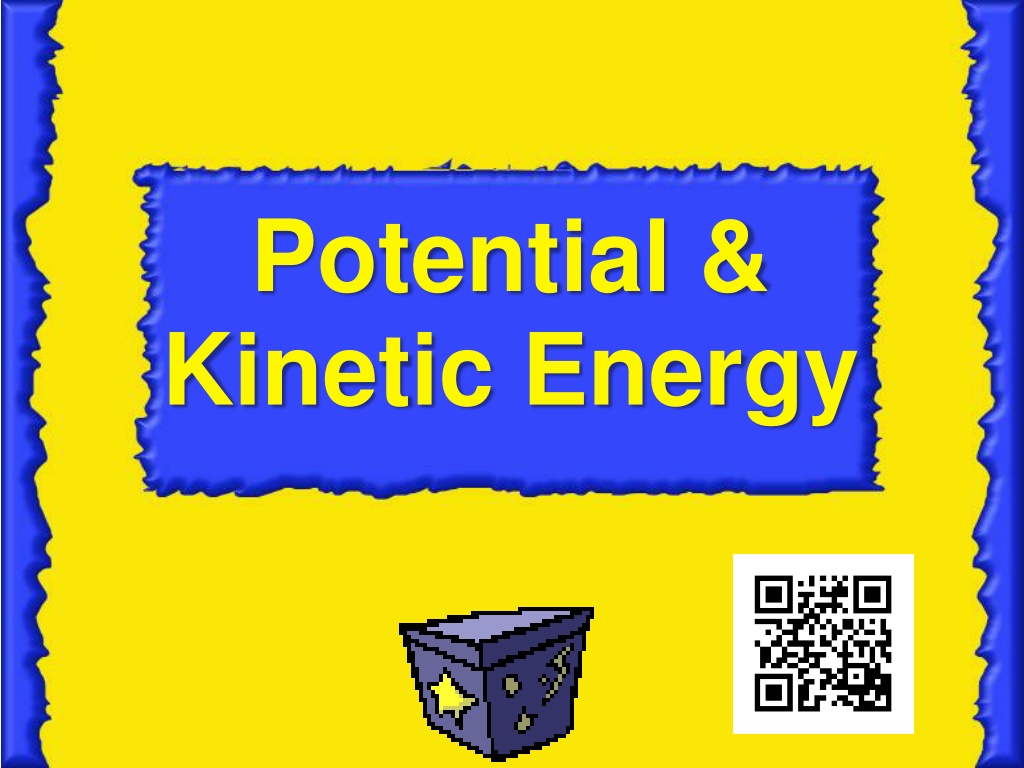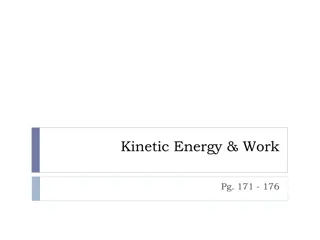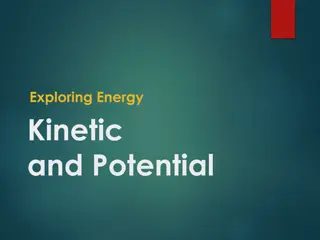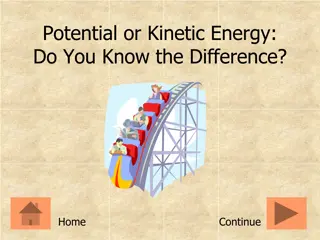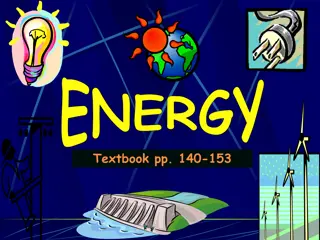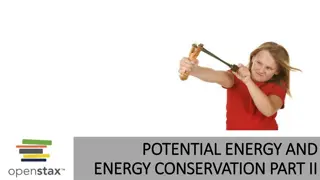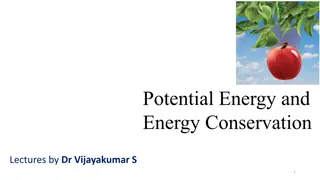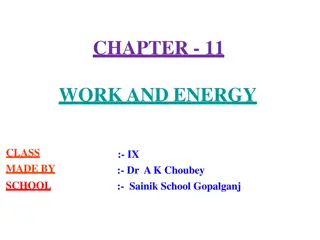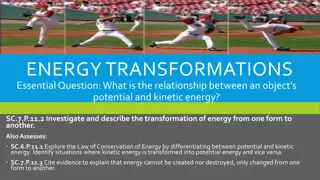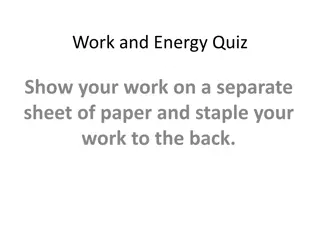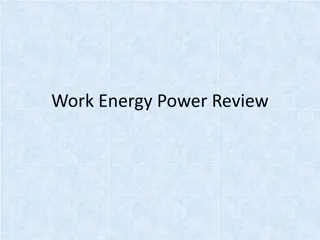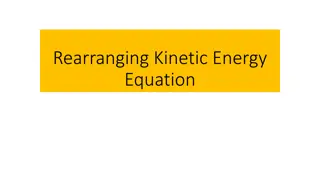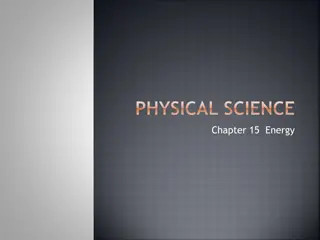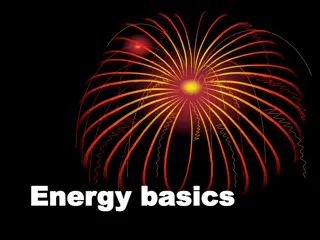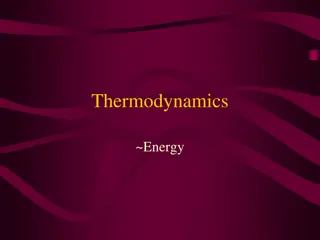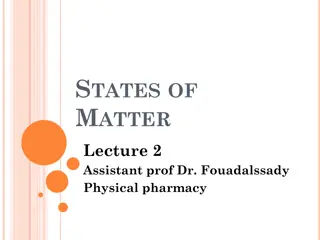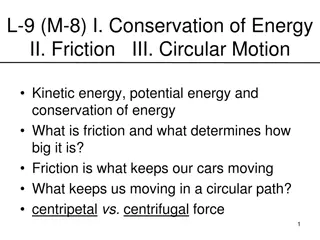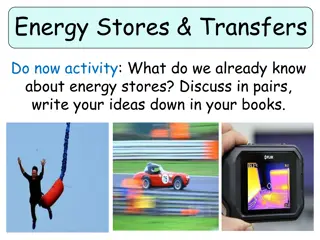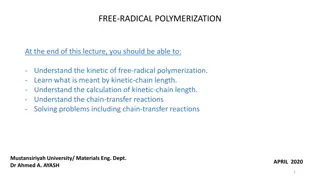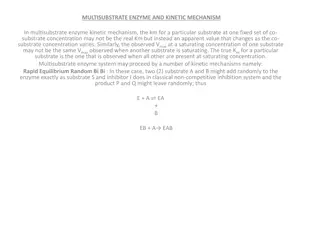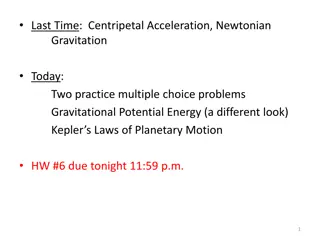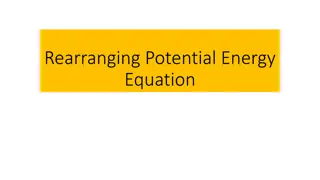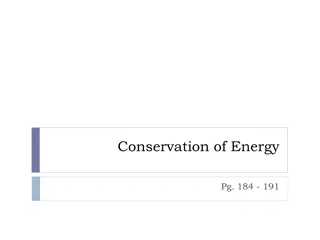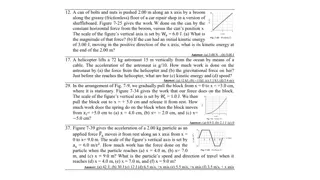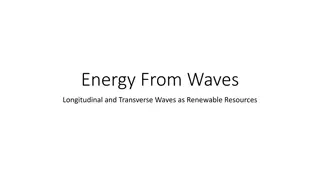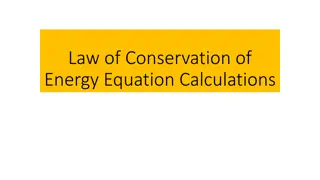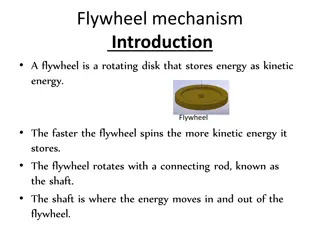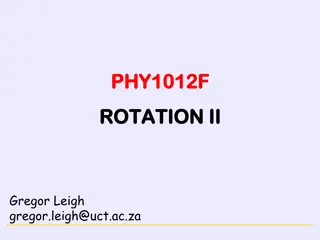Understanding Kinetic and Potential Energy
Explore the relationship between potential and kinetic energy, as well as how energy causes change in objects. Learn about kinetic energy, speed, mass, and their impact on energy transfer through engaging examples and explanations.
Download Presentation

Please find below an Image/Link to download the presentation.
The content on the website is provided AS IS for your information and personal use only. It may not be sold, licensed, or shared on other websites without obtaining consent from the author. Download presentation by click this link. If you encounter any issues during the download, it is possible that the publisher has removed the file from their server.
E N D
Presentation Transcript
Potential & Kinetic Energy
Essential Question: How are potential & kinetic energy related? Standard: S8P2b. Explain the relationship between potential and kinetic energy.
Concept Attainment Activity [see resources]
Use the Kinetic & Potential Energy Graphic Organizer to take notes.
WHAT IS ENERGY? Energy is the ability to cause change. Everything around you has energy, but you notice it only when a change takes place. Anytime a change occurs, energy is transferred from one object to another.
Explain how these objects cause change
Things that move can cause change. For example, a bowling ball rolls down the alley and knocks down some pins. Is energy involved? A change occurs when the pins fall over. The bowling ball causes this change, so the bowling ball has energy. As the ball moves, it has a form of energy called kinetic energy.
Kinetic Energy Kinetic energy is the energy an object has due to its motion. If an object isn t moving, it doesn t have kinetic energy.
Kinetic Energy and Speed Let s use our bowling ball example. If you roll the bowling ball so it moves faster, what happens when it hits the pins? A faster ball causes more change to occur than a ball that is moving slowly. Kinetic energy increases as an object moves faster.
Kinetic Energy & Mass Suppose you roll a volleyball down the alley instead of a bowling ball. If the volleyball travels at the same speed as a bowling ball, do you think it will send pins flying as far? An important difference between the volleyball and the bowling ball is that the volleyball has less mass. Even though the volleyball is moving at the same speed, it has less kinetic energy because is has less mass. Kinetic energy increases as the mass of an object increases.
The Basics of Kinetic Energy Kinetic Energy is the energy of motion. Kinetic energy increases as an object moves faster. Kinetic energy increases as the mass of an object increases.
What if the bowling ball is not moving? Does it still have energy?
Potential Energy Potential energy is the energy stored in an object because of its position. It has the potential to cause change.
Potential Energy Imagine our bowling ball is sitting on a table. It has Potential Energy as it sits on the table because it has the ability to cause change. Potential Energy changes to Kinetic Energy What happens if the bowling ball falls off the table?
Potential Energy What happens to the Potential Energy of the bowling ball if the table is higher? The Potential Energy of an object is greater if the position of the object is higher. The object has the potential to cause more change.
Potential Energy How does mass affect the Potential Energy of an object? has, the more potential energy it has because it has the potential to cause more change. The more mass an object
The Basics of Potential Energy Potential Energy is stored energy. Potential Energy is greater if the position of an object is higher. Potential energy increases as the mass of an object increases.
Changing Kinetic Energy & Potential Energy Activity Use the QR Code activity to introduce the relationship between kinetic energy and potential energy if possible. Otherwise, use slides 21-27 with animations to demonstrate the concepts.
Changing Kinetic & Potential Energy In a previous slide, we discussed how the potential energy of an object can change to kinetic energy. For example, when you are holding the bowling ball, it has potential energy. As you release the ball, most of its energy is kinetic. However, as the ball begins to slow its kinetic energy decreases. But, the total energy of the ball hasn t changed. The decrease in kinetic energy equals the increase in potential energy. The total amount of energy remains constant.
Changing Kinetic & Potential Energy http://www.classzone.com/books/ml_sci ence_share/vis_sim/mem05_pg69_pot ential/mem05_pg69_potential.html
Changing Kinetic & Potential Energy http://www.physicsclassroom.com/mmedia/energy/ce.cfm
Changing Kinetic & Potential Energy http://www.physicsclassroom.com/mmedia/energy/ie.cfm
Changing Kinetic & Potential Energy KE = Kinetic Energy PE = Potential Energy W = Work TME = Time http://www.physicsclassroom.com/mmedia/energy/se.cfm
Changing Kinetic & Potential Energy Shooting a Dart http://www.physicsclassroom.com/mmedia/energy/dg.cfm
Changing Kinetic & Potential Energy Pendulum http://www.physicsclassroom.com/mmedia/energy/pe.cfm
Changing Kinetic & Potential Energy http://www.physicsclassroom.com/mmedia/energy/hw.cfm
Changing Kinetic & Potential Energy http://www.physicsclassroom.com/mmedia/energy/hh.cfm
Changing Kinetic & Potential Energy http://www.classzone.com/books/ml_scienc e_share/vis_sim/mfm05_pg126_coaster/mf m05_pg126_coaster.html
Watch the video clip of the cartoon Road Runner. Identify at least two examples of Kinetic Energy and two examples of Potential Energy http://www.youtube.com/watc h?v=8H41zbqrwVo
Other Suggested Activities: Trill Ride Activity, Spool Racer, or Button Whizzer Kinetic & Potential Energy Images Science of NHL Hockey
